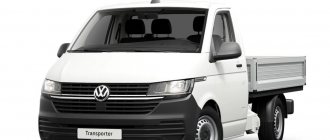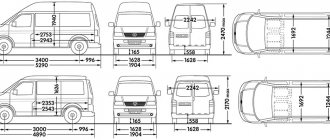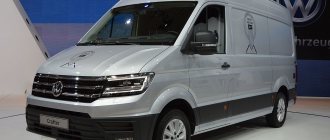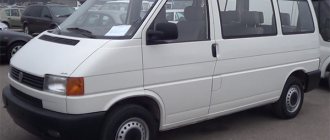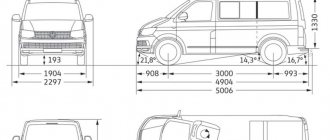Specifications
By the nature of its operation, despite the overall dimensions of the Volkswagen Transporter T4, it is a passenger car: maneuverable, compact and lightweight. Along with this, the VW T4 is equipped with a chassis with a high margin of safety and excellent maintainability. The dimensions of the Volkswagen Transporter T4 depend on the body type, which is usually divided into three types:
- Passenger - up to 9 seats.
- Cargo-passenger - 3-5 seats.
- Cargo - 3 places.
The curb weight of the vehicle is 1580 kg. The permissible loading weight must not exceed 2580 kg. For the Volkswagen Transporter, body dimensions vary over a wide range, which determines the body type:
- width: large - 1840 mm, reduced - 1620 mm;
- length: standard - 5107 mm, reduced - 4789 mm;
- height: standard - 1900 mm, reduced - 1350 mm, increased - 1940 mm.
As already mentioned, VW models are highly resistant to corrosion. This is achieved thanks to the technology of aging steel after stamping, galvanizing parts and using mixtures to increase the adhesion of the paint and varnish coating to the metal surface.
Model history
One day, the Dutch importer Ben Pon came to the Volkswagen plant. The action took place in 1947. Ben saw a platform built on the basis of the famous Beetle and decided that all of Europe might need a light-duty truck during the recovery period after World War II. Ben shared his idea, supported by sketches, with the CEO of Volkswagen, who later brought this idea to life. The presentation of the first Transporter took place in April 1949, and just a year later the first copy rolled off the assembly line.
Heinrich Nordhov, General Director of Volkswagen, presented the van as a model with ideal weight distribution along the axles. At the rear there was a small engine and a fuel tank, and in front, in contrast to all this, were the driver and passenger. The cargo compartment was located between the axles, so no matter how much cargo was in the car, the weight distribution remained equal. By the way, up to 890 kg could be loaded into the T1. Then the first generation was replaced by the second, the third, more familiar to Russia, came out and the time came for the fourth Transporter. And today the sixth generation of the mini-truck is on sale.
Gasoline or diesel
If, when purchasing a Volkswagen Transporter, the problem arises of choosing between a car with a diesel or gasoline engine, you should take into account that the fundamental difference between a diesel engine and a gasoline engine is the method of ignition of the combustible mixture. If in a gasoline engine a spark created by a spark plug ignites fuel vapors mixed with air, then in a diesel engine spontaneous combustion occurs under the influence of compressed air heated to a high temperature.
Diesel and gasoline engines have their advantages and disadvantages
It is generally accepted that a diesel engine is more durable, but cars with such engines are usually more expensive than gasoline versions, all other things being equal. At the same time, among the advantages of diesel, the following should be mentioned:
- its efficiency - fuel consumption is usually 10–15% lower than in gasoline engines;
- higher reliability due to the absence of an ignition system;
- environmental friendliness - the level of CO2 emissions is lower than in gasoline engines.
Diesel, as a rule, has more traction, but is also noisier. Among its disadvantages:
- increased “sensitivity” to low-quality fuel - repairs in this case can be quite expensive;
- more expensive maintenance;
- problems with starting in frosty weather.
Despite the fact that more and more diesel cars are being produced all over the world, in Russia such cars are still noticeably inferior in popularity to gasoline vehicles.
VW Transporter with diesel engine has TDI badge on the radiator
Pros and cons of the model
The Volkswagen T6 model is considered very successful. Main advantages:
- the car is equipped with electronics that make driving easier;
- several versions of MT6 allow you to choose a minibus according to your needs and capabilities;
- fuel consumption is reduced. Compared to VT 5, it decreased by 2.5 liters (per 100 km) in the city and by 4 liters when driving outside the metropolis.
But it is worth noting the disadvantages: the ground clearance has decreased to 165 mm, which makes the car less suitable for driving on bad roads. A number of users are unhappy with the plastic inserts on the dashboard.
Typical malfunctions and “sores” of cars
After many years of use, various problems may appear, such as:
- Worn left rear wheel. If a problem occurs, a tire with a tread of less than 1.6 mm should be replaced.
- There is noise from the rear, especially when driving on uneven roads. Most likely, this is a broken rear suspension spring that needs to be replaced.
- Gear Shifting Problems – Difficulty shifting into gears. This is quite common across the Caravelle range. The problem is caused by the gear train. In this case, you will have to adjust the levers and the corresponding gear rod.
- A decrease in power when going uphill is a problem with the air flow meter. The air flow meter will need to be replaced to resolve the problem. Buying a new part can be expensive, but you can save money on a quality used part.
- Side sliding door failure. The fault is caused by the door runners. You can adjust the slides to solve the problem, but if that doesn't work, you'll have to replace the door slides.
VW T4 configurations
The design of the T4 is quite practical, its bulky body can accommodate up to 5.4 cubic meters of cargo. Load capacity 800-1200 kg, total vehicle weight 2.5-2.8 tons. Access to the cargo area is easy thanks to sliding side doors and two wide-opening rear doors. The loading height is only 51.5 cm. The dashboard has a minimalist style, the center console is not cluttered.
The basic equipment includes the following:
- Five-speed manual transmission, four-speed automatic;
- Transmission The internal combustion engine drives the front wheels;
- Front triangular suspension, rear independent, leaf spring suspension;
- Assistive systems ABS (anti-lock braking system);
- Power steering, hydraulic steering;
- Tire size 215/60 R16 H, wheel size R16.
The van is equipped with five cylinders, and since 1995 power steering has been included as standard. In addition to the typical VW T4 Transporter model, a recreational vehicle was produced as an MPV in three versions, as well as a motorhome that can be used as a regular transport, for mini-offices, camping, and a family car.
external links
- Wikimedia Commons contains a media category for Volkswagen Transporter
. - "Official Volkswagen page in Spanish". Archived from the original on December 1, 2008.
- thesamba.com. "Bus Literature" (in English).
- encombi.com. "Volkswagen Dictionary".
- solokombis.com.ar. "The History of the German VW Kombi".
- commercial.volkswagen.es. "History of Commercial Vehicles". Archived from the original on November 5, 2012.
- {{web citation|url= https://webs.ucm.es/BUCM/escritores/silvana_castro/obras/obr7688.php%7Ctítulo=A Brief History of the Volkswagen T1
- [3] All the information to convert your van step by step, plus camper and transporter travel stories
| authoritative control |
|
- Data: Q719895
- Multimedia: Volkswagen Type 2
Spectacular appearance of T4
For the fourth time, the technical characteristics and design of the Volkswagen T4 minivan model have changed. In the updated design, it is worth noting the redesigned transmission. This time the decisions of the company's engineers were more radical - the car was deprived of rear-wheel drive, replacing it with front-wheel drive. Moreover, models with all-wheel drive appeared, which increased the technical capabilities of the already famous car at that time.
The car is produced with several types of bodies. The basic version of the configuration received an unglazed cargo body.
The modification for passenger transportation was named Caravelle. The distinctive features are excellent quality plastic, three rows of seats with quick removal. And although the interior is upholstered in plastic, this characteristic does not spoil the interior. In the cold season, two heating units were responsible for comfort and warmth in the cabin.
Multivan is a modification that has received seats located next to each other in the cabin. The extendable table in the middle of the interior added to the car's advantages.
The flagship version of the minivan was the Vestfalia/California modification, equipped with a lifting roof and various equipment. At the end of the millennium, the model was updated - now the hood, fenders, and the front of the car have changed. Note that each time the company’s engineers and designers managed to successfully work on improving the car.
Design
The car has a truly revolutionary design for that time. The car received more angular body shapes and smoother lines. I must admit that it looks more boring than the first generation, it is all imbued with German practicality. And its resistance coefficient was 0.36, which was inaccessible to competitors and their models in this class.
At the top of the short hood of the Volkswagen Transporter T4, located at a large negative angle, there is a narrow air intake. The front optics have a rectangular shape and slightly rounded yellow turn signals. Between the optics there is a wide false radiator grille, which is divided into unequal parts by a thin plastic trim. The bumper with a pronounced “shelf” has a concave lower part with moldings for fog lights.
In profile, the car has a door that slides back on rails, a wide stamping that runs in a straight line from the front optics to the rear. Extended wheel arches and small air intake slits in the front fender. Depending on the modification, the side of the body may be glazed, or may have metal panels instead of glass. Door handles are usually made of unpainted plastic.
The rear of the car is also variable. This applies to both the glazing and the trunk lid itself. In modifications for transporting passengers there is one and it opens upward, but in Transporter cargo there are two of them and they open on both sides.
On the sides there are almost square lights with several sections, and under the “U”-shaped there is a rear bumper, into the sides of which fog lights are integrated.
As for modifications, there were several of them. Firstly, there were two types of body length (short and long version). The car also came with different roof heights.
The following body types were available:
- Panel Van - the modification had glazing only in the front part of the body;
- Kombi Van – the front and middle parts of the body were glazed;
- Multivan – full glazing;
- Doka – five-seat cabin and chassis;
- There was also a flatbed truck model with a three-seater cab.
Dimensions:
- length – 4707 mm/5107 mm;
- width – 1840 mm;
- height – 1940 mm/2430 mm;
- wheelbase – 2930 mm/3320 mm;
- load capacity up to 1105 kg.
Advantages and disadvantages
The Transporter T4 has a clean, purposeful design. The advantages include:
- Wide range of interior finishing options with curtains and seats that convert into a bed;
- Long wheelbase;
- Five-cylinder TDI diesel engine offering up to 56km/h on the 4.5L, a reasonable 144km/h;
- Panoramic view, all obstacles and dangers ahead are visible;
- For the 2.5TDI engine, you can perform chip tuning to improve performance.
- The roof of the body is waterproof, sound insulation and thermal insulation are at the highest level.
Many T4 owners note such disadvantages as:
- It is impossible to stand up straight in the van; when cooking or washing dishes, it is not very convenient;
- Over time, rust forms and paint defects appear;
- The VR6 powerplant consumes too much fuel;
Device
The body is a solid steel frame, where all parts are rigidly connected by welding. All types use a cargo-type platform, which is connected to the frame with bolted fasteners. The Volkswagen Transporter T4 is distinguished by its radiator grille, which characteristically stands out above the original plastic insert. It is worth noting that even then the modular assembly of removable parts (doors, wings, hood) was used for their convenient and high-quality replacement. The windshield on the Volkswagen Transporter T4 is beveled, providing good visibility.
Volkswagen Transporter T4 interior
Everything is well thought out in terms of safety:
- The driver's row of seats is structurally separated from the passenger row. In the event of a frontal impact, the force is partially absorbed by elements of the engine compartment; in the case of a side impact, the force is partially absorbed by reinforced inserts of the side doors and pillars.
- The visibility for the driver has been improved, and the dashboard of the Volkswagen Transporter T4, to which the gearshift lever has been moved, has become more ergonomic.
- Each element determines its location as accurately as possible - the angle of the panel, the distance between the instruments, color lighting and the display system - which allows minimal distraction of the driver’s attention from the road and control.
As with all VW models, the weight distribution is stable and even, ensuring even axle loads. The loading volume can be further increased by installing a roof rack on the Volkswagen Transporter T4.
Overall dimensions of Volkswagen Transporter T4
Chassis
Starting with these models, front-wheel drive is installed, but a well-proven visco coupling ensures all-wheel drive on difficult sections of the route (ice, mountainous terrain, off-road, rough terrain).
New axle with independent front suspension. The Volkswagen Transporter T4 torsion bar or spring rear suspension and low-frame chassis provide high shock absorption and reduced floor load.
Engine
The engine determines the main characteristics of the car. This is the first line in which the installation of a V-1.8 carburetor engine was stopped and the installation of diesel units began. The first modification in which the engine is already located in front. The power range is 60-115 hp. s., 4 and 5 cylinders, respectively, as many as glow plugs on the Volkswagen Transporter T4.
Engine 1.9TD Volkswagen Transporter T4
Modification of engines installed in cars of different configurations and determining the fuel consumption of the Volkswagen Transporter:
- Diesel engines. The fuel consumption of the Volkswagen Transporter T4 DD is significantly less, given the increased traction power, for which they have no equal. They are indispensable in rough and mountainous terrain, where descents and ascents predominate.
ModificationNumber of cylinders/VPower, l. s.Consumption 90 km/h/GC, l
| TR 1.9D | 4 / 1896 | 60 | 8,9 |
| TR 1.9 TD | 4 / -/- | 68 | 9,0 |
| TR 2.4 D | 5 / 2370 | 78 | 9,4 |
| Tr 2.5 TDI DNVT | 5 / 2461 | 102 | 9,1 |
| Tr 2.5 TDI DNVT | 5 / 2461 | 88 | 8,9 |
- Gasoline engines. Their resource is 500-700 km higher. They fail less often and allow you to reach higher speeds, up to 164 km/h.
ModificationNumber of cylinders/VPower, l. s.Consumption 90 km/h/GC, l
| TR 2.0 | 4 /1968 | 84 | 11,7 |
| TR 2.5 | 5 /2461 | 115 | 13,4 |
The model is equipped with a 5-speed manual transmission; on the Volkswagen Transporter T4, starting with the 3rd generation car, the engine is installed in a transverse position and is water-cooled.
Brake system
Front and rear brakes can be fully disc or combined: front disc and rear drum. Ventilated discs are installed on Ø 15″ wheels. The system itself consists of a master cylinder and a 2-circuit system (one circuit ensures that 2 wheels stop diagonally). The vehicle is reinforced with a vacuum device and a pressure regulator. ABS is installed on the front wheels.
Features of the Volkswagen Transporter T4 brake system
Performance indicators
Actual fuel consumption may differ from the nominal one due to the long production resource
The maximum speed that a VW can achieve is 132-164 km/h. Acceleration speed to 100 km is 16-24 seconds. Consumption on the highway is much lower, but in the urban cycle it averages up to 10 l/100 km.
Despite the fact that these cars are considered “indestructible”, and they feel great on Russian roads, they still have a number of specific features.
For example, a running system in which the following often fails:
- oil seals;
- steering rods;
- depressurization of the power steering;
- ball joints;
- wheel bearings;
- stabilizer.
Diesel engine problems:
- Injection pump - fuel pump, depressurization and loss of fluid;
- replacement of spark plugs and glow system;
- turbocharger;
- fuel injection system.
For petrol models Volkswagen Transporter T4, fuel system:
- ignition coils;
- starter.
Volkswagen Transporter T4 is widely used in various fields
Video
Model VW Transporter T4 is a modern unit with a full set of new developments. It was produced from 1990 to 2003. Technical characteristics of the Volkswagen Transporter T4 have undergone changes in all respects over the course of 13 years of production. The car is represented by the largest number of models, varying in:
- engine power and fuel type;
- configurations;
- purpose.
This model range was discontinued 15 years ago, but despite this, you can find cars with 25 years of service in excellent condition. In addition to the owner’s good care of his equipment, this is due to the excellent corrosion protection of the body. This is especially noticeable in the example if we consider which is better: Volkswagen Transporter or Ford Transit. The latter, which is not inferior in its parameters to VW, has 2 drawbacks: rapid corrosion of the body and poor supply of spare parts. And only thanks to constructive continuity, VW models are free of all these shortcomings, despite the fact that they have been out of production for 15 years.
Another pleasant bonus will be the opportunity to find out that the cars produced by the concern in the period 1990-2000 have a high margin of safety, and many buyers prefer the 4th generation model when choosing.
"Volkswagen T4 Transporter": reviews, photos, characteristics
The fourth generation of Volkswagen Transporter light-duty vehicles first appeared back in 1990. The model turned out to be so successful that they decided not to close serial production. Thus, the Volkswagen Transporter T4 was produced until 2003. After that, it was replaced by the fifth generation of these light-duty trucks. Why motorists love the Transporter T4 so much, photos and a review of the car are further in our article.
Design
For 1990, this car looked very modern. Then sharp chopped forms were held in high esteem. The design of the car did not have expressive and smooth lines. This is a simple workhorse that must perform its function without fail - transporting small items and materials. Design did not come first as it does now. The car was actively used in city services in Germany. In old films, by the way, you can see police and collector T4s.
We also note that the car was produced in several body versions. There was a short and an extended modification (see photo above). Thus, the length of the body ranged from 4.7 to 5.1 meters, and the height - from 1.94 to 2.43. The width of all modifications was unchanged - 184 centimeters. A total of six versions of the Volkswagen Transporter T4 were available. The vehicle was offered with a double or single cabin, with a flatbed body or a platform for installing various elements. Volkswagen Transporter T4 passenger minibuses with panoramic glazing were no less in demand. They were called “Multivan” and were equipped with a separate motor, which we will mention during the review.
Despite such angular shapes and rectangular optics, the car turned out to be very attractive and - importantly - with the lowest aerodynamic drag coefficient. The body geometry is designed so that this parameter does not exceed 0.36 Cx. For cars of this class this was a kind of record. Are there any problems with the body of the Transporter T4 car? Reviews from owners note that the metal is perfectly protected from corrosion. Thus, the manufacturer galvanized the panel of the load-bearing body, and filled the internal cavities (including the thresholds) with hot wax, which prevented the occurrence of corrosion.
However, after twenty years, rust began to appear in the sandblasted areas. These are the sills and wheel arches. There was also corrosion between the second and third windows. Nevertheless, there is no through rot even on the bottom, and this is a big plus for a car of this age.
Salon
The interior of the Volkswagen Transporter T4 was made simply and without frills.
The design is typical for that time. Simple angular shapes and minimal inserts. Owner reviews note one feature. Despite the fact that the car was produced in 1990, the ergonomics here are at the modern level. All buttons and control levers are located as conveniently as possible for the driver. There are also many niches and drawers inside. The seats are moderately hard and have good lateral support. Because of their convenience, these seats are often installed on domestic GAZelles and Sobols. The passenger modification was designed for 9 people, including the driver. As for the Volkswagen Transporter T4 truck, the load capacity was 1200 kilograms. This was quite enough for a car of this class.
The car handled cargo transportation “excellently,” as noted by the owners’ reviews. By the way, in passenger versions the interior can be transformed. The seat backs can be folded into a convenient table. And when transporting large items, remove them from the sled altogether. Fortunately this is done very quickly.
Specifications
The fourth generation of “Transporters” was equipped with different engines. Among the gasoline ones there were units with a volume of 2 to 2.5 liters. They produced power of 84-115 horsepower. But in most cases, the Volkswagen T4 Transporter came with diesel engines. Thus, in the basic configuration it was equipped with a 68-horsepower unit with a displacement of 1.9 liters.
But the most successful is considered to be the 2.5-liter diesel engine, which developed 110 horsepower.
"Multivan"
Separately, it is worth noting the power unit for the passenger modification “Multivan”. This Volkswagen T4 Transporter was equipped with a 2.8-liter six-cylinder gasoline engine. The unit was distinguished by a V-shaped arrangement of cylinders and developed a power of 204 horsepower. These characteristics are sufficient even in modern operating conditions. Acceleration to hundreds took 11 and a half seconds. The maximum speed is 194 kilometers per hour.
Suspension
It uses a double wishbone independent suspension. In the rear there are telescopic shock absorbers and coil springs (not on all versions). Disc brakes are installed all around. The control mechanism is rack and pinion, additionally equipped with a hydraulic booster. Reviews note the presence of weak stabilization struts. Silent blocks and levers are sold as a set, and replacing them will cost a tidy sum (however, this needs to be done once every 200 thousand kilometers). Otherwise, the suspension does not require attention and pleases with reliable operation.
Transmission
Basically, the Volkswagen T4 Transporter was equipped with a five-speed manual transmission. However, there was a 4-speed automatic in the lineup. How reliable is the transmission in the Transporter T4 car? Box repair (partial) is required after 150 thousand kilometers. Over time, the fluoroplastic bushings of the scenes fail. Also, the fifth gear gear “cuts off” on the secondary shaft, causing the bearings to fail. If the transmission was equipped with an intermediate suspension support, you should pay attention to the oil seal. It may leak.
As for maintenance, according to the manufacturer, the oil in the manual transmission is filled for the entire service life. But since the car is more than 20 years old, motorists still recommend changing the lubricant (preferably at one hundred thousand). As for automatic transmissions (of which there are very few on 4th generation Transporters), the oil should be changed every 60 thousand. Otherwise, the torque converter will fail.
Motorists speak very positively about the Volkswagen T4 Transporter. Despite its age, the machine continues to delight with its reliability. The fourth “Transporter” copes well in Russian winter conditions, does not require frequent repairs, and has a strong body that does not rot. Thanks to the front-wheel drive, the car is easy to control, and the suspension handles potholes and bumps well. Noise insulation is performed at a decent level.
Among the shortcomings, it is necessary to note the lack of new spare parts. If you manage to find a part, it is only from disassembly (with the exception of consumables). The 1.9-liter engine has very weak dynamics. If you buy it, it will be the 2.5-liter unit. Another problem is the damper clutch. Its resource is quite large, but at 300-400 thousand it requires replacement. The price of a damper clutch is $600-$800. Also, door hinges sag after 20 years.
Transmission
The Volkswagen T4 forever broke with the established tradition: rear-wheel drive and an engine located behind the rear axle. The minibus became front-wheel drive with a motor in the front. Power is taken from the engine using a 5-speed manual or 4-speed automatic.
In the all-wheel drive version of Syncro 4×4, the distribution of torque between the axles is carried out through a viscous coupling, which, when the front wheels slip, connects the rear ones. The presence of Syncro will require additional operating costs: a suspended bearing and an elastic driveshaft coupling, gearbox seals or a humming rear gearbox.
Some owners are looking to convert regular versions into all-wheel drive. Fortunately, such modernization is quite possible and can be successfully solved in specialized services.
Prices for new VW Transporter and used cars
In 2022, the cost of a VW Transporter on the primary market, depending on the configuration, ranges from 1 million 700 thousand rubles to 3 million 100 thousand rubles. The price of a used Transporter depends on the year of manufacture and can be:
- 1 million 200 thousand - a car manufactured in 2015;
- 950 thousand-1 million rubles - 2010–2012 model year;
- 500 thousand - 2003–2005 model year.
T5 2003 mileage 250,000, during all the time I changed the chassis, spark plugs and washer pump once, I won’t talk about maintenance. You don’t get tired while driving, you don’t feel the speed, you drive and relax behind the wheel. Advantages: excellent car, economical - 7l on the highway, 11l in winter. Disadvantages: expensive spare parts, BOSH heater, in winter only on winter diesel fuel, otherwise you fill it up - it gets blocked, you go to the computer, you can’t do it yourself.
Malfunctions
The model today has a large list of shortcomings that were identified over a 20-year service life. The weak point is considered to be the body, which is easily susceptible to corrosion.
The Transporter's gearbox does not last long either: the manual one runs up to 300,000 km, and the automatic one up to 200,000 km. On Russian roads, the suspension suffers greatly, which has to be rebuilt every 120,000 miles.
The vacuum brake booster pump is also considered a consumable material.
The car is sold in large quantities and in various modifications on the secondary market, and its cost is in the price range from 200,000 to 400,000 rubles.
Despite the large list of shortcomings, the Transporter T4 is warmly received by Russian car enthusiasts, since parts for it are not difficult to find, and all breakdowns are caused by the owners’ careless attitude towards the “workhorse”. Most copies, after 20 years, still perform their tasks at the highest level.
Model range and modifications of Volkswagen Transporter T4
Constructed at the Transporter T4 specialist plant in Hannover (Germany), it was available in SWB (short wheelbase) or LWB (long wheelbase). The model range and modifications include the following options:
- Panel Vans - no windows behind the C-pillar, one row of seats.
- EuroVan – two side windows, sliding door.
- Combi-Van – additional windows between B and C pillars, 2 rows of seats.
- Caravelle – has 5, 7, 8, 9 seats.
- Single Cab Pickup is a single-seat pickup truck with a cab based on the SWB chassis.
- Double Cab Pickup - a pickup truck with a double cab based on the LWB chassis
- Syncro 4×4 is a universal model, suitable for transporting passengers and cargo.
- 1990-1995: several model changes, a choice of petrol and diesel units were offered.
- 1996 – main reconstruction of the model. Changes include rear disc brakes, a one-piece rear bumper, and a 2.5-liter TDI engine.
- The Caravelle VR6 was introduced with a longer hood to accommodate the new engine.
- In the summer of 2003, production of the T4 was discontinued in Hannover to be replaced by the new generation T5.
Sources
- https://ospetstehniki.ru/articles/tehnicheskie-harakteristiki-volkswagen-transporter-t4.html
- https://bumper.guru/zarubezhnye-avto/volkswagen/folksvagen-transporter-tehnicheskie-harakteristiki-2.html
- https://carsclick.ru/volkswagen/obzor/t4/
- https://naperevoz.ru/transport/furgony/harakteristiki-folksvagen-transporter-t4.html
- https://formula-avto26.ru/folksvagen/teh-harakteristiki-folksvagen-transporter-t4.html
- https://vvm-auto.ru/volkswagen/556-volkswagen-transporter-t4
[collapse]
T1, T1.5, T2, T3
| T1, T1.5, T2, T3 | ||
| Total information | ||
| Parameter | ||
| Parameter | Rear engine / rear or all wheel drive | |
| Other models | ||
| Connected | Volkswagen Sedan | |
| [edit data in Wikidata] | ||
T1
Volkswagen Transporter T1 plus 8 (1960) increases load capacity.
Transporter and Kombi
in Europe,
Kombi
for the entire range in Brazil.
- 1950-1967 (Germany)
- 1957-1975 (Brazil)
The T1's front window is split and can be opened, while the T2's is solid and fixed. Brazil, one of VW's signature production countries outside of Germany, along with Mexico and South Africa, also produced the T1. The T2 was later produced in the same manner, and was the only country where it continued to be produced until its eventual worldwide withdrawal. Sales of the Combi (T2) ceased entirely in 2013 due to local regulations that required all new cars to be fitted with airbags.
In the first three generations, its engine was air-cooled. Its design is simple and easy to maintain. Over time, the engine was modified to reduce fuel consumption and pollution levels.
The German version of the T1 ended in 1967, and the Brazilian model was partially modified in 1976 as the T1.5.
T1.5
Combi T1.5 Van.
Kombi
or
Furgão
for the entire range in Brazil and
Kombi
or
Furgón
for Argentina (in the latter case as a result of the
Autolatina
Ford-VW merger).
- 1976–1996 (Brazil)
- 1981–1988 (Argentina)
The Volkswagen Kombi T1.5 features the front fascia of the T2 generation and the air intake in the rear fascia of the T1 generation, including its "sliding" and non-sliding side doors. That is, it’s practically a T1, with a T2 cabin.
T2
Volkswagen Bus T2c Kombi Prata
, the last one produced with an air-cooled engine.
Transporter
and
Kombi
in Europe,
Kombi
or
Furgão
in Brazil,
Combi
,
Panel
and
Caravelle
in Mexico and
Microbus
in the US and Canada.
- 1967-1979 (Germany)
- 1971-1994 (Mexico) In 1988, a 1.8-liter water-cooled engine with a front radiator and grille from the Golf 1.8 was adapted for sale, and in 1993, due to environmental measures introduced in the country, a 1.8-liter engine With the fuel injection technology was introduced, which equipped it with a sensor system controlled by the on-board computer and a three-component catalytic converter.
- 1997-2013 (Brazil) In Brazil, following the local trend, the boxer engine was replaced in late 2005 by a water-cooled 4-cylinder inline 1.4 with Total Flex technology, capable of using ethanol or gasoline, unclear.
T3
Main article: Volkswagen T3
Volkswagen Caravel T3 Syncro
Transporter
,
Kombi
and
Caravelle
in Europe;
T25
in the UK and Ireland and
Vanagon
in the US and Canada.
- 1979-1992 (Germany)
- 1990-2003 (South Africa)
This version was distributed in very small numbers in Central and South America. In Mexico in particular, they jumped from T2 to T4, and even both generations were sold at the same time. [ link needed
]

